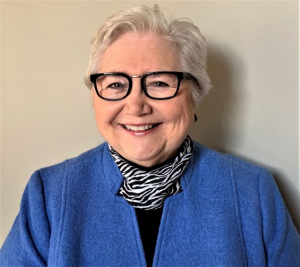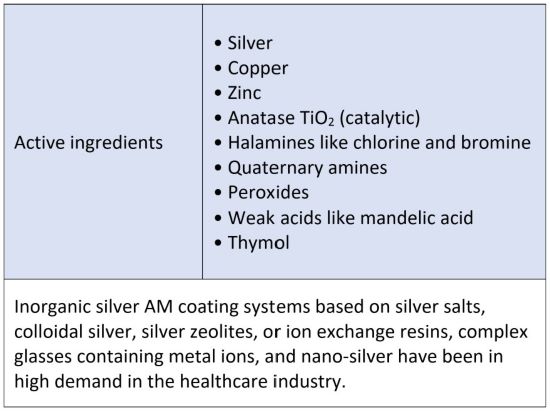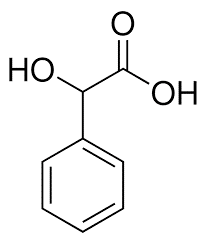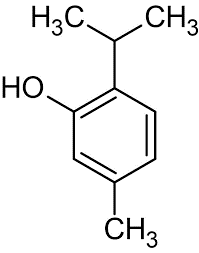Improving Global Health with Coatings Technology

 Victoria Scarborough This quarterly column, written by Victoria Scarborough, Ph.D., Vice President Collaborative Innovation of The ChemQuest Group, Inc., provides a look into the latest trends and technologies within the coatings and adjacent industries that impact the value chain.
Victoria Scarborough This quarterly column, written by Victoria Scarborough, Ph.D., Vice President Collaborative Innovation of The ChemQuest Group, Inc., provides a look into the latest trends and technologies within the coatings and adjacent industries that impact the value chain.
Specialized paint can provide mechanisms for maintaining hygiene that prevent disease spread, protect water and sanitation systems, reduce the spread of fire, improve indoor air quality, and help to ensure the safety of the food supply chain. Other areas like lead abatement and infrastructure protection only add to the value provided by specialized coatings.
Ongoing research and development seeks to improve coating performance, while federal and state regulators want to impose limits on the use of any active ingredient with toxic environmental persistence. In addition, today’s consumers are more health-conscious than ever, and they want to know what ingredients are in the products they bring into their homes. The trend of ingredient transparency is on the rise, with consumers actively seeking information about the impact of product ingredients on their health.
The yin and yang of creating coatings that improve personal safety without harming the environment places formulators on a knife’s edge of meeting both needs. What is the state of the current landscape, and which new technologies might meet future demands?
Anti-Microbial Coatings
Anti-microbial (AM) coatings help prevent the spread of infectious diseases by reducing the presence of bacteria, viruses, and fungi on many types of surfaces (e.g., metal, plastic, wood, and textiles). Consumers want products that claim to kill or inhibit the growth of bacteria and viruses, emphasizing the intrinsic link between cleanliness and health. Professionals like healthcare workers, teachers, public employees, hotel workers, food processing staff, and transportation workers rely on easy-to-clean coatings that provide quick and unfailing elimination of microbes to avoid the spread of disease.
When a coating includes an AM additive that claims to kill a pathogen, it must be registered with the U.S. Environmental Protection Agency (EPA) and all U.S. states. This adds significant cost and time to the process of introducing new products and is a significant deterrent to the development of new AM technologies. However, the global pandemic sharpened the focus on quickly finding highly effective AM technologies to keep the population safe. Several existing, as well as new AM technologies have made it to market, and others are in development.
Numerous proven anti-microbial agents are used in paint and coatings that meet the EPA standards for killing pathogens (Table 1). In particular, quaternary amine and copper are used in products from major paint manufacturers like Sherwin-Williams, PPG, and Behr. In addition, a number of silver-containing products used to treat textiles are also offered as powder coatings (PPG). These offerings are not without some drawbacks, as copper has an inherent green color that hinders the formulation of bright-white paints, and quaternary amines are coming under scrutiny by regulators.
TABLE 1 | Proven anti-microbial agents used in paint and coatings.

Because the need is so great for effective AM solutions, the European Union (EU) has funded a program under EU Horizon Europe called SUPREME (Sustainable Nanoparticles Enabled Antimicrobial Surface Coatings).1 The SUPREME consortium has four years (from January 2023 to December 2026) to develop a platform of efficient and multi-functional anti-microbial nanocoatings using TiO2 nanoparticles that have demonstrated AM activity. The consortium has 10 partners in eight countries sharing €4.7 million (approximately $5.1 million) in funding.
The SUPREME coating models will follow a sustainable-by-design approach that considers both the toxicity and environmental impact to guarantee market acceptance and sustainability while having a robust safety assurance in place for human health. The goals balance the need for safety as well as performance.
New AM materials that have shown promise in the market include peroxides that degrade to form water and oxygen. A Florida-based startup company called Quick Med Technologies has successfully demonstrated reversible binding of hydrogen peroxide (HP) within a zinc oxide (ZnO) complex. The ZnO matrix sequesters HP into a non-volatile form that can bind tightly to fibers as well as non-porous surfaces. In the presence of moisture, HP is released in a controlled manner, creating a highly localized yet potent “kill zone” for viruses and bacteria.
The company claims the solution is more effective because it is non-toxic, durable, long lasting, and does not contribute to the development of resistant organisms. Testing showed an inactivation of viruses and resistant species of public health concern above 99.99% in under four hours, as well as long-term durability, validating the potential of the technology. Development work is ongoing for formulating and testing a new coating containing the additive.
The cosmetic industry is often at the forefront of new and interesting AM ingredients, which might be adapted for use in paints and coatings. One such ingredient is mandelic acid.2 Derived from bitter almond extract, mandelic acid is an mild organic acid that has been shown to penetrate the bacterial cell membrane and inhibit protein synthesis (Figure 1).
FIGURE 1 | Mandelic acid has stronger anti-microbial properties and better stability than alcohol.

Results suggest that mandelic acid has stronger anti-microbial properties and better stability than alcohol, as well as being anti-fungal and anti-viral. It is incorporated into skin care products to control acne and body odor caused by bacteria. While it has not been tested in a coating to date, the material has been well-characterized and is not persistant in the environment.
In addition to the cosmetic industry, the household, industrial, and institutional (HI&I) market uses several products designed to clean surfaces and eliminate microbial contamination. In keeping with the consumer desire for safety and transparency, many are using microbicides derived from nature. One example is thymol, a botanical disinfectant derived from thyme essential oil (Figure 2).3
FIGURE 2 | Thymol is an anti-viral, anti-bacterial, anti-fungal, and anti-septic agent.

Thymol is a phenolic monoterpene that has long been used in traditional medicine as an anti-viral, anti-bacterial, anti-fungal, and anti-septic agent. In 2009, the EPA concluded that thymol has minimal potential toxicity and poses minimal risk to human health. While not yet seen in a paint or coating system, this active ingredient may be yet another safe alternative to the traditional and more persistent anti-microbials.
Hygienic Coatings
Hygienic coatings are used in facilities where health and safety are a top priority, such as healthcare, pharmaceutical, and food manufacturing sites. Food processing facilities are regulated by the U.S. Food & Drug Administration (FDA), and coatings must be approved for direct, indirect, or incidental contact with food products.
Paint must be FDA certified for use on ceilings, cleaning areas, containers, equipment, floors, kitchens, storage rooms, walls, and waste disposal areas. A number of coating resin systems are approved for use in these areas, but they must also be non-toxic, bacteria- and chemical-resistant, durable to cleaning, and have enhanced resistance to cracking and flaking from the surface.
In hospitals, healthcare-acquired infections (HAIs) are a serious public health issue, and hygienic paints are used on walls, ceilings, baseboards, floors, and especially operating rooms to reduce the risk of infection. While many manufacturers use silver as an active ingredient, a trend is growing for the development of metal-free products with more favorable toxicity profiles. Some companies have turned to the FDA for help.
The FDA publishes a list of regulated ingredients that are generally recognized as safe (GRAS), and recent patents show ingredient manufacturers developing combinations of GRAS organic acids for inclusion in paints and coatings as broad-spectrum AM additives.4 This type of approach will become more mainstream as continued downward regulatory pressures force manufacturers to respond. Expect more research into the use of natural or biomimetic antimicrobials in the near future.
Fire-Resistant Coatings
The intensity, frequency, and duration of wildfires have all increased in recent years, destroying millions of hectares of land and property, and sadly killing firefighters and those who live in the fire zone. Intense heatwaves associated with climate change provide more ignition sources for wildfires, as lightning strikes, over-loaded electrical grids, and strong winds create a deadly combination for frequent wildfire events. The primary air pollutants from wildfire smoke are particulate matter, including carbon monoxide, nitrogen dioxide, nitric acid, and volatile organic compounds (VOCs).
While fire-resistant or intumescent coatings have long existed for use in buildings, the need is increasing for coatings that provide fire protection to exterior siding, eaves, soffits, and overhangs to protect against the rapid spread of wildfires. Described in the California Building Codes for Exterior Wildfire Exposure, these coatings must be ignition resistant for 30 minutes according ASTM E84.5 Weatherization standards described in ASTM D2898 Method B must be met to ensure water and UV resistance in exterior environments.
In addition, the International Code Council (ICC) clearly describes the minimum standards for other building materials associated with mitigating wildfire hazards. By providing more of these types of exterior wildfire protection coatings that comply with standards, some measure of defense can be provided to those in areas prone to deadly wildfires.
Abatement Systems
Lead and asbestos abatement involve the process of safely removing lead paint or asbestos insulation during renovation projects. Any renovation, repair, or painting project in a pre-1978 home or building can easily create dangerous lead dust or asbestos fibers.
For these projects, encapsulation coatings are used to coat the surface and cover the lead/asbestos surface. This is considered a temporary measure since these coatings can wear away. Ultimately, the lead and asbestos must be removed.
Advancements in technology are slowly replacing traditional methods of removal. One of the most cutting-edge methods for lead paint and asbestos removal is laser abatement. Laser-induced breakdown spectroscopy (LIBS) involves using a laser pulse to create a small plasma spark on the material’s surface.6 The emitted light is captured and analyzed, providing near-instantaneous results about the presence and concentration of elements such as lead or asbestos.
Laser technology allows for the precise targeting of hazardous materials, breaking them down without causing further dispersion. This technique eliminates the need for scraping, sanding, or using chemical solvents, which can pose additional risks.
Another method of removal is to use robotics. Robots equipped with specialized tools and sensors can access hard-to-reach areas, reducing the need for manual labor and minimizing risks for workers. Here, paint and technology intersect to create a safer environment, reducing potential health hazards.
Final Thoughts
Paint and coatings contribute to global health in many unseen ways, like reducing the risk of infection, keeping our food supply chain safer, giving us more time to escape a fire, and eliminating exposure to dangerous materials. In a post-pandemic world, it is necessary to evaluate the limits of our existing technologies and find ways to push the envelope toward better, more efficient products that are safer, less environmentally persistent, and meet customer demands.
The paint and coatings industry has a platform upon which to respond to the many health needs of the global community. The lives we touch with our products may depend on it.
To learn more, reach out to vscarborough@chemquest.com or visit https://chemquest.com.
References
1 Sustainable Antimicrobial Nanocoatings for High-touch Surfaces, Horizon Europe, Horizon-CLE-2021-Resilience Program. www.cordis.europa.eu/project/id/101058422
2 Research on the Electron Structure and Antimicrobial Properties of Mandelic Acid and Its Alkali Salts, International Journal of Molecular Sciences, 4 February, 2023.
3 Thymol and Thyme Essential Oil- New Insights into Selected Therapeutic Applications, Molecules 2020, 25, 4125.
4US Patent 223/0383093 A1, Composition and Method for Microbial Control for Use with Polymers, Microban Products Co., Nov 30, 2023.
5 California Building Standards Code, Materials and Construction Methods for Exterior Wildfire Exposure, 2022
6Industrial Applications of Laser-induced Breakdown Spectroscopy: A Review, Analytical Methods, 2020, 8. https://doi.org/10.1039/C9AY02728A.
Looking for a reprint of this article?
From high-res PDFs to custom plaques, order your copy today!







